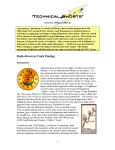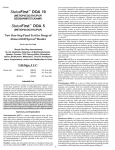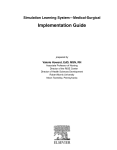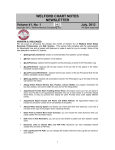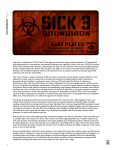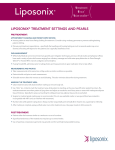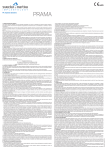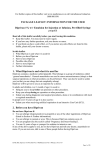Download PACKAGE LEAFLET: INFORMATION FOR THE USER Diazepam
Transcript
Read all of this leaflet carefully before you start to take this medicine. - Keep this leaflet. You may need to read it again while you are receiving your treatment. - If you have any further questions, please ask your doctor or pharmacist. - This medicine has been prescribed for you. Do not pass it on to others. It may harm them, even if their symptoms are the same as yours. - If any of the side effects get serious, or if you notice any side effects not listed in this leaflet, please tell your doctor or pharmacist. Wockhardt UK Limited Measure bar should be 150mm at 100% scale Customer Diazepam Injection leaflet W-LFT001 Description Profile 5.2pt 460mm x 150mm 104323-4 Size Item Code Min. Point Size Colours Used Process Black Keyline (non-printing) Text Free Area (non-printing) CLINICAL PARTICULARS 4.1 Therapeutic indications Diazepam injection may be used in severe or disabling anxiety and agitation; for the control of status epilepticus, epileptic and febrile convulsions; to relieve muscle spasm; as a sedative in minor surgical and dental procedures; or other circumstances in which a rapid effect is required. 4.2 Posology and method of administration Dosage depends on individual response, age and weight. Adults: In severe anxiety or acute muscle spasm, diazepam 10mg may be given intravenously or intramuscularly and repeated after 4 hours. In tetanus, 0.1 to 0.3mg per kg bodyweight may be given intravenously and repeated every 1-4 hours; alternatively, a continuous infusion of 3 to 10mg per kg every 24 hours may be used or similar doses may be given by nasoduodenal tube. In status epilepticus or epileptic convulsions, 0.15-0.25mg per kg (usually 10-20mg) is given by intravenous injection. The dose can be repeated if necessary after 30 to 60 minutes. Once the patient is controlled, recurrence of seizures may be prevented by a slow infusion (maximum total dose 3mg per kg over 24 hours). In minor surgical procedures and dentistry, 0.1-0.2mg per kg by injection (usually 10-20mg) adjusted to the patient’s requirements. Elderly: Elderly or debilitated patients should be given not more than half of the usual dose. Hepatic/renal impairment Dosage reduction may also be required in patients with liver or kidney dysfunction. Children: In status epilepticus, epileptic or febrile convulsions: 0.2-0.3mg per kg (or 1mg per year of life) is given by intravenous injection. The dose can be repeated if necessary after 30 to 60 minutes. Sedation or muscle relaxation: up to 0.2mg per kg may be given parenterally. Neonates: Not recommended; dosage has not been established and Diazepam Injection contains benzyl alcohol which should be avoided in injections to neonates. IMPORTANT: In order to reduce the likelihood of adverse effects during intravenous administration the injection should be given slowly (1.0ml solution per minute). It is advisable to keep the patient supine for at least an hour after administration. Except in emergencies, a second person should always be present during intravenous use and facilities for resuscitation should always be available. It is recommended that patients should remain under medical supervision until at least one hour has elapsed from the time of injection. They should always be accompanied home by a responsible adult, with a warning not to drive or operate machinery for 24 hours. Intravenous injection may be associated with local reactions and thrombophlebitis and venous thrombosis may occur. In order to minimise the likelihood of these effects, intravenous injections of diazepam should be given into a large vein of the antecubital fossa. Where continuous intravenous infusion is necessary it is suggested that 2ml Diazepam Injection is mixed with at least 200ml of infusion fluid such as Sodium Chloride Injection or Dextrose Injection and that such solutions should be used immediately. There is evidence that diazepam is adsorbed onto plastic infusion bags and giving sets. It is therefore recommended that glass bottles should be used for the administration of diazepam by intravenous infusion. 4.3Contraindications Known sensitivity to benzodiazepines or any of the ingredients Severe or acute respiratory insufficiency/depression Sleep apnoea syndrome Severe hepatic insufficiency Avoid injection in neonates (contains benzyl alcohol) Diazepam injection should not be used in phobic or obsessional states nor be used alone in the treatment of depression or anxiety associated with depression due to the risk of suicide being precipitated in this patient group. Diazepam Injection should not be used for the primary treatment of psychotic illness. In common with other benzodiazepines the use of diazepam may be associated with amnesia and Diazepam Injection should not be used in cases of loss or bereavement as psychological adjustment may be inhibited. 4.4 Special warnings and precautions for use Diazepam injection should be used with caution in patients with renal or hepatic dysfunction (see 4.2 Posology and Method of Administration), chronic pulmonary insufficiency, porphyria, muscle weakness, myasthenia gravis, coma, a known history of drug or alcohol abuse, or organic brain changes, particularly arteriosclerosis. Diazepam may enhance the effects of other CNS depressants; their concurrent use should be avoided. Elderly and debilitated patients are more prone to the CNS effects of benzodiazepines and, therefore, lower doses are required (see section 4.2 Posology and Method of Administration). Benzodiazepines should be used with caution in the elderly as long term use is associated with an increased risk of developing dementia. Dependence and withdrawal symptoms The dependence potential of diazepam increases with dose and duration of treatment and is greater in patients with a history of alcohol or drug abuse (see 4.8 Undesirable Effects). It is low when limited to short term use. Withdrawal symptoms may occur with benzodiazepines following normal use of therapeutic doses for only short periods and may be associated with physiological and psychological sequelae (see Section 4.8 Withdrawal symptoms). This should be considered when treating patients for more than a few days; abrupt discontinuation should be avoided and the dose reduced gradually. Amnesia Benzodiazepines may induce anterograde amnesia (see 4.8 Undesirable Effects). The condition occurs most often several hours after administration. UK 4 Market PHARMACEUTICAL FORM Solution for Injection. Clear, colourless to pale yellow liquid. English 3 Language QUALITATIVE AND QUANTITATIVE COMPOSITION Diazepam 5mg/ml Excipients - Contains Benzoic acid (E210) 1mg/ml, Ethanol 96% 100mg/ml, Sodium benzoate (E211) 49mg/ml, Benzyl alcohol 15mg/ml, Propylene glycol 400mg/ml and Sodium Content - 0.34mmol/ml. For a full list of excipients, see section 6.1 To reduce the risk, where appropriate and possible, patients should be able to have an uninterrupted sleep of 7-8 hours after administration. Use in patients with concomitant mental illness As with other benzodiazepines, extreme caution should be used if prescribing diazepam for patients with personality disorders. The disinhibiting effects of benzodiazepines may be manifested as the precipitation of suicide in patients who are depressed or show aggressive behaviour towards self and others. Benzyl alcohol poisoning This medicinal product contains 15mg/ml of benzyl alcohol. There is a risk of benzyl alcohol poisoning with prolonged use of high-dose intravenous infusions of diazepam injection containing benzyl alcohol. Benzyl alcohol may cause toxic reactions and anaphylactoid reactions in infants and children up to three years old. Must not be given to premature babies or neonates. This medicinal product contains benzoic acid and sodium benzoate which may increase the risk of jaundice in newborn babies. This medicinal product contains 0.34mmol sodium per ml. To be taken into consideration by patients on a controlled sodium diet. This medicinal product contains 12.5 vol % ethanol (alcohol), i.e. 100mg per ml. Harmful for those suffering from alcoholism. To be taken into account in pregnant or breast-feeding women, children and high-risk groups such as patients with liver disease or epilepsy. 4.5 Interaction with other medicinal products and other forms of interaction Alcohol: Enhanced sedation or respiratory or CNS depression with concomitant administration of diazepam. Concomitant use should be avoided. General anaesthetics and narcotic analgesics: Enhanced sedation or respiratory and cardiovascular depression. If such centrally acting depressant drugs are given parenterally in conjunction with intravenous diazepam, severe respiratory and cardiovascular depression may occur; careful monitoring is required. When intravenous diazepam is to be administered concurrently with a narcotic analgesic agent (e.g. fentanyl), it is recommended that diazepam be given after the analgesic and that the dose be carefully titrated to meet the patient’s needs. Premedication with diazepam may decrease the dose of fentanyl derivatives required for induction of anaesthesia. Antibacterials: Agents that interfere with metabolism by hepatic enzymes (isoniazid and to a lesser extent erythromycin) may reduce the clearance of diazepam and potentiate its action. Known inducers of hepatic enzymes, for example, rifampicin, may increase the clearance of diazepam. Antidepressants: Enhanced sedation or respiratory or CNS depression with concomitant administration of mirtazapine or tricyclic antidepressants. Diazepam plasma levels increased by concomitant fluvoxamine or fluoxetine. Antiepileptics: Enhanced sedation or respiratory and cardiovascular depression. Known inducers of hepatic enzymes, for example, carbamazepine, phenobarbital and phenytoin, may increase the clearance of benzodiazepines, however, despite enzyme stimulation, the net effect of adding these antiepileptics can be augmentation of benzodiazepine-induced sedation. Serum phenytoin levels may rise, fall or remain unaltered. In addition, phenytoin may cause diazepam serum levels to fall. Concomitant sodium valproate may increase serum levels of diazepam, with associated drowsiness. Antihistamines: Enhanced sedation or respiratory and cardiovascular depression with sedative antihistamines. Antihypertensives: Enhanced hypotensive effect with concomitant administration of ACE inhibitors or beta-blockers or calcium-channel blockers or vasodilator hypertensives e.g. hydralazine. Enhanced sedative effect with alpha blockers and possibly moxonidine. Antipsychotics: Enhanced sedation or respiratory and cardiovascular depression. Increased plasma concentrations of zotepine. Severe hypotension, collapse, respiratory depression, potentially fatal respiratory arrest and unconsciousness have been reported in a few patients on benzodiazepines and clozapine. Caution is advised when initiating clozapine therapy in patients taking benzodiazepines. Increased risk of hypotension, bradycardia and respiratory depression with concomitant administration of parenteral benzodiazepines with intramuscular olanzapine. Antivirals: Amprenavir, ritonavir and saquinavir have been shown to reduce the clearance of diazepam and may potentiate its actions, with risk of extreme sedation and respiratory depression – avoid concomitant use. Anxiolytics: Enhanced sedation or respiratory and cardiovascular depression with other anxiolytics. Digoxin: Reduced clearance of digoxin. Disulfiram: has been shown to reduce clearance and may potentiate actions of benzodiazepines. Diuretics: Enhanced hypotensive effect when benzodiazepines and diuretics are used concomitantly. Dopaminergic agents: diazepam may cause inhibition of levodopa. Hypnotics: Enhanced sedation or respiratory and cardiovascular depression. Lofexidine: Enhanced sedation or respiratory and cardiovascular depression. Muscle relaxants: Increased CNS depressant effects with baclofen and tizanidine. Nabilone: Enhanced sedation or respiratory and cardiovascular depression. Nicotine: Diazepam metabolism is accelerated by smoking. Nitrates: Enhanced hypotensive effect when benzodiazepines and nitrates are used concomitantly. Oral contraceptives: May reduce the clearance of diazepam and potentiate its actions. Sedatives: Enhanced sedation or respiratory and cardiovascular depression. Sodium oxybate: Enhanced CNS depressant effects of sodium oxybate with concomitant benzodiazepines. Ulcer-healing drugs: Cimetidine, omeprazole and esomeprazole have been shown to reduce the clearance of diazepam and may potentiate its actions. Xanthines: Diazepam metabolism is accelerated by theophylline. Sedative effects of diazepam reduced by caffeine. Sedative effects of diazepam reversed with concomitant administration of aminophylline. 4.6 Pregnancy and lactation There is no evidence regarding the safety of diazepam in pregnancy, however, diazepam and its metabolite desmethyldiazepam freely cross the placenta and accumulate in the fetal circulation. It should not be used, especially in the first and third trimesters, unless the benefit is considered to outweigh the risk. If the product is prescribed to a woman of childbearing potential she should be warned to contact her physician regarding the discontinuance of the product if she intends to become or suspects that she is pregnant. There may be a small increase in the risk of congenital malformation, particularly oral cleft, with the use of benzodiazepines in the first trimester. In labour, high single doses or repeated low doses have been reported to produce effects on the neonate, such as hyperbilirubinaemia, hypothermia, hypotonia, respiratory depression and poor suckling (floppy infant syndrome) and irregularities in the foetal heart. tom.robertson 2 Diazepam 5mg/ml Solution for Injection Proof By NAME OF THE MEDICINAL PRODUCT 2 SUMMARY OF PRODUCT CHARACTERISTICS 1 10/03/2014 Your doctor will decide the right dose for you. The dosage depends on the condition being treated, weight and age. If you do not understand what you are being given then ask your doctor or nurse. The usual doses are as follows: 117 3. How to take Diazepam Injection Pharma Code You should NOT be given Diazepam Injection if you: • are allergic (hypersensitive) to diazepam, any other benzodiazepines or to any of the other ingredients in Diazepam Injection (see section 6, Further information) • are suffering from phobias (irrational fears) or obsessions • have breathing problems • suffer from obstructive sleep apnoea (a condition where you stop breathing during sleep) • have severe liver disease • have suffered recent loss or bereavement as diazepam can cause memory loss • suffer from depression, anxiety or other long standing mental illness, for which you are not being treated. Diazepam Injection should not be used in premature or newborn babies. Talk to your doctor before being given Diazepam Injection if you: • have kidney or liver disease • suffer from lung disease • suffer from porphyria (a disease of blood proteins affecting the skin, gut and nervous system) • suffer from myasthenia gravis (a disease of the nervous system causing muscle weakness) • have a history of alcohol and/or drug abuse • suffer from brain disease (particularly diseases affecting the blood circulation of the brain) • if you take any medicines which affect the central nervous system. Caution should be taken when giving Diazepam Injection to the elderly and comatose patients. Taking other medicines Please tell your doctor or pharmacist if you are taking or have recently taken any other medicines, including medicines obtained without a prescription. The following medicines can affect or be affected by treatment with Diazepam Injection: • medicines used to treat bacterial infections (e.g. erythromycin isoniazid and rifampicin) • medicines used to treat depression (e.g. mirtazapine, fluvoxamine and fluoxetine) • medicines used to treat fits (e.g. carbamazepine, phenobarbital, phenytoin and sodium valproate) • medicines used in surgery (general anaesthetics) and strong pain killers (narcotic analgesics e.g. fentanyl) Proof No. 2. Before you take Diazepam Injection 479026 The name of your medicine is Diazepam Injection; the active ingredient is diazepam. This medicine belongs to a group of medicines called benzodiazepines. Diazepam Injection is used: • to treat anxiety and agitation • as a sedative on minor surgical and dental procedures • as an anticonvulsant (medicine to control fits) • as a muscle relaxant. Date 1. What Diazepam Injection is and what it is used for • m edicines used to treat allergies, including hay fever and insect bites (antihistamines) • medicines used to treat high blood pressure • m edicines used to treat psychosis, schizophrenia and other mental illnesses (e.g. onlanzapine, clozapine and zotepine) • m edicines used to treat HIV infection (e.g. amprenavir, saquinavir and ritonavir) • medicines used to treat anxiety and sleep disturbance • d igoxin (used to treat abnormal heart rhythms and heart failure) • disulfiram (used to treat alcoholism) • levodopa (used to treat Parkinson’s Disease) • lofexidine (used to reduce symptoms of heroin withdrawal) • baclofen and tizanidine (muscle relaxants) • nabilone (used to treat nausea and nerve pain) • oral contraceptives (“The Pill”) • theophylline and aminophylline (used in asthma and lung diseases) • c imetidine, esomeprazole and omeprazole (used to treat excess stomach acid and ulcers). • Diuretics (water tablets). • Nitrates, used in the treatment of angina. • S odium oxybate, used to prevent episodes of sudden onset of sleep (narcolepsy) with muscle weakness. Taking Diazepam Injection with food and drink You should avoid smoking and drinking alcohol whilst taking this medicine. Some of the ingredients of coffee (caffeine) will affect the way Diazepam Injections work. Pregnancy and breast-feeding You should not use this medicine if you are pregnant or breast feeding (unless your doctor decides it is essential). Tell your doctor straight away if you think you may be pregnant or intend to start a pregnancy. Driving and using machinery This medicine can affect your ability to drive. Do not drive whilst taking this medicine until you know how this medicine affects you. It may be an offence to drive if your ability to drive safely is affected. There is further information for patients who are intending to drive in Great Britain - go to http://www.gov.uk/drug-driving-law Important information about some of the ingredients in Diazepam Injection This medicine contains • 1 2.5 vol % ethanol (alcohol) i.e. 100mg per ml, equivalent to 10ml beer, 4ml wine per dose. It is therefore harmful to those suffering from alcoholism. This should also be taken into account in pregnant or breast-feeding women, children and high risk groups such as patients with liver disease or epilepsy. • 1 5mg/ml of benzyl alcohol and so must not be given to premature or newborn babies. It may cause toxic and/or allergic reactions in infants and children up to three years. • s odium benzoate (E211) and benzoic acid (E210) which may increase the risk of jaundice in newborn babies. • 0 .34mmol/ml of sodium. This should be considered in patients on a controlled sodium diet. Artwork No. In this leaflet: 1. What Diazepam Injection is and what it is used for 2. Before you take Diazepam Injection 3. How to take Diazepam Injection 4. Possible side effects 5. How to store Diazepam Injection 6. Further information Warning! We cannot accept responsibility for any errors in this proof after approval. Whilst we take extreme care at all times to ensure accuracy to our clientʼs brief, the final responsibility must be taken by our client. (Refer to as Diazepam Injection in this leaflet) IF YOU SIGN THIS PROOF YOU ARE SIGNIFYING FULL APPROVAL OF DESIGN AND TEXT. PACKAGE LEAFLET: INFORMATION FOR THE USER Diazepam 5mg/ml Solution for Injection Diazepam 5mg/ml Description Customer 104323-4 Diazepam Injection leaflet Wockhardt UK Limited Measure bar should be 150mm at 100% scale Item Code Colours Used Process Black Keyline (non-printing) Text Free Area (non-printing) 104323/4 W-LFT001 10 DATE OF REVISION OF THE TEXT Profile UK: 08/02/2008 Ireland: 22/05/2009 Malta: 29/05/2009 5.2pt 9DATE OF FIRST AUTHORISATION/RENEWAL OF THE AUTHORISATION 460mm x 150mm MARKETING AUTHORISATION NUMBER(S) PL 29831/0065 PA 1339/6/1 PA 1339/6/2 MA 154/01103 Size 8 Min. Point Size MARKETING AUTHORISATION HOLDER Wockhardt UK Ltd Ash Road North Wrexham LL13 9UF UK UK 7 Market PHARMACEUTICAL PARTICULARS 6.1 List of excipients Benzoic acid (E210) Ethanol Propylene glycol Sodium benzoate (E211) Benzyl alcohol Water for Injections 6.2Incompatibilities Diazepam Injection should not be mixed with other drugs in the same infusion solution or the same syringe. 6.3 Shelf life Three years For single use only. Discard any remaining contents 6.4 Special precautions for storage Keep container in the outer carton to protect from light. Do not store above 25°C 6.5 Nature and contents of container Amber Type I PhEur glass ampoules (2ml or 4ml) packed in 10s in an outer printed carton. 6.6 Special precautions for disposal None English 6 Language PHARMACOLOGICAL PROPERTIES 5.1 Pharmacodynamic properties Diazepam is a psychotropic substance from the class of 1,4-benzodiazepines with marked properties of suppression of tension, agitation and anxiety as well as sedative and hypnotic effects. In addition, diazepam demonstrates muscle relaxant and anticonvulsive properties. It is used in the short-term treatment of anxiety and tension states, as a sedative and premedicant, in the control of muscle spasm and in the management of alcohol withdrawal symptoms. Diazepam binds to specific receptors in the central nervous system and particular peripheral organs. The benzodiazepine receptors in the CNS have a close functional connection with receptors of the GABA-ergic transmitter system. After binding to the benzodiazepine receptor, diazepam augments the inhibitory effect of GABA-ergic transmission. 5.2 Pharmacokinetic properties Diazepam is highly lipid soluble and crosses the blood brain barrier. These properties qualify it for intravenous use in short term anaesthetic procedures since it acts promptly on the brain, and its initial effects decrease rapidly as it is distributed into fat deposits and tissues. Following the administration of an adequate intravenous dose of diazepam, effective plasma concentrations are usually reached within 5 minutes (ca. 150-400 ng/ml). Absorption is erratic following intramuscular administration and lower peak plasma concentrations may be obtained than those following oral administration. Diazepam is extensively protein bound (95-99%). The volume of distribution is between 0.95 and 2 l/kg depending on age. Diazepam and its main metabolite, N-desmethyldiazepam, cross the placenta and are secreted in breast milk. Diazepam is metabolised predominantly in the liver. Its metabolites, N-desmethyldiazepam (nordiazepam), temazepam and oxazepam, which appear in the urine as glucuronides, are also pharmacologically active substances. Only 20% of the metabolites are detected in the urine in the first 72 hours. Diazepam has a biphasic half life with an initial rapid distribution phase followed by a prolonged terminal elimination phase of 1-2 days. For the active metabolites N-desmethyldiazepam, temazepam and oxazepam, the half lives are 30-100 hours, 10-20 hours and 5-15 hours, respectively. Excretion is mainly renal and also partly biliary. It is dependent on age as well as hepatic and renal function. Metabolism and elimination in the neonate are markedly slower than in children and adults. In the elderly, elimination is prolonged by a factor of 2 to 4. In patients with impaired renal function, elimination is also prolonged. In patients with hepatic disorders (liver cirrhosis, hepatitis), elimination is prolonged by a factor of 2. 5.3 Preclinical safety data Chronic toxicity studies have demonstrated no evidence of drug induced changes. There are no long term animal studies to investigate the carcinogenic potential of diazepam. Several investigations pointed to a weakly mutagenic potential at doses far above the human therapeutic dose. Local tolerability has been studied following single and repeat dose applications into the conjunctival sac of rabbits and the rectum of dogs. Only minimal irritation was observed. There were no systemic changes. In humans it would appear that the risk of congenital abnormalities from the ingestion of therapeutic doses of benzodiazepines is slight, although a few epidemiological studies have pointed to an increased risk of cleft palate. There are case reports of congenital abnormalities and mental retardation in prenatally exposed children following overdosage and intoxication with benzodiazepines. tom.robertson 5 Proof By Flumazenil is indicated to counteract the central depressive effect of benzodiazepines but expert advice is essential since adverse effects may occur (e.g. convulsions in patients dependent on benzodiazepines). Flumazenil should not be used in mixed overdoses or as a diagnostic test. Flumazenil is contraindicated in the presence of drugs that reduce seizure threshold (e.g. tricyclic antidepressants). 2 104323/4 10/03/2014 Leaflet Prepared: February 2014 Proof No. Product name Reference number Diazepam 5mg/ml solution for PL 29831/0065 injection This is a service provided by the Royal National Institute of Blind People. Marketing Authorisation Holder: Wockhardt UK Ltd, Ash Road North, Wrexham, LL13 9UF, UK. Manufacturer: CP Pharmaceuticals Ltd, Ash Road North, Wrexham, LL13 9UF, UK. 117 What Diazepam Injection contains The active ingredient is: diazepam 5mg/ml The other ingredients are: benzoic acid (E210), ethanol, propylene glycol, sodium benzoate (E211), benzyl alcohol and water for injections. What Diazepam Injection looks like and the contents of the pack Diazepam Injection is a clear colourless to yellow solution. The medicine is supplied in 2ml or 4ml amber glass ampoules in a cardboard outer carton. Other formats: To listen to or request a copy of this leaflet in Braille, large print or audio please call, free of charge: 0800 198 5000 (UK Only). Please be ready to give the following information: Date 6. Further information Pharma Code Infants born to mothers who take benzodiazepines chronically during the latter stages of pregnancy may develop physical dependence and may be at some risk for developing withdrawal symptoms in the postnatal period. A small number of children exposed in utero to benzodiazepines have shown slow development in the early years but by four years of age had developed normally. Since benzodiazepines are found in the breast milk, benzodiazepines should not be given to breast feeding mothers. 4.7 Effects on ability to drive and use machines Patients treated with Diazepam Injection should not drive or use machinery. This medicine can impair cognitive function and can affect a patient’s ability to drive safely. This class of medicine is in the list of drugs included in regulations under 5a of the Road of Traffic Act 1988. When prescribing this medicine, patients should be told: • The medicine is likely to affect your ability to drive • Do not drive until you know how the medicine affects you • It is an offence to drive while under the influence of this medicine. •However, you would not be committing an offence (called ‘statutory defence’) if: oThe medicine has been prescribed to treat a medical or dental problem and oYou have taken it according to the instructions given by the prescriber and in the information provided with the medicine and o It was not affecting your ability to drive safely. 4.8 Undesirable effects The side effects of diazepam are usually mild and infrequent. Blood and lymphatic system disorders: Blood dyscrasias including thrombocytopenia and agranulocytosis have been reported with diazepam. Immune system disorders: Hypersensitivity reactions, including anaphylaxis, are rare. Psychiatric disorders: Numbed emotions. In susceptible patients, an unnoticed depression may become evident. Paradoxical reactions (including aggression, rage, hostility, hallucinations, nightmares, disinhibition, euphoria, excitation, irritability, restlessness, increased anxiety, agitation, inappropriate behaviour and insomnia) are known to occur with benzodiazepines and may be quite severe with diazepam. They are more likely to occur in children and the elderly. Nervous system disorders: Elderly or debilitated patients are particularly susceptible to the CNS effects of benzodiazepines. It is recommended that dosage be limited to the smallest effective dose and increased gradually, if necessary, to decrease the possibility of development of ataxia, dizziness, and oversedation, which may lead to falls and other accidents (see 4.2 Posology and method of administration). Long term use of benzodiazepines in the elderly may be associated with an increased risk of dementia. Headaches, confusion, slurred speech, tremor, reduced alertness and drowsiness. Anterograde amnesia may occur using therapeutic doses, the risk increasing at higher doses (see 4.4 Special Warnings and Special Precautions for Use). Amnestic effects may be associated with inappropriate behaviour. Extrapyramidal effects and convulsions have occurred rarely with diazepam. Eye disorders: Visual disturbances. Ear and labyrinth disorders: Rarely, vertigo Cardiac disorders: Hypotension, particularly with high dosage, bradycardia, chest pain. Cardiac arrest may occur with diazepam injection. Vascular disorders: Diazepam injection may be associated with thrombophlebitis and venous thrombosis. Respiratory, thoracic and mediastinal disorders: Rarely, respiratory depression and apnoea, particularly with high dosage. Gastrointestinal disorders: Rarely, salivation changes, including dry mouth or excessive salivation and gastrointestinal disturbances including nausea. Hepatobiliary disorders: Raised liver enzymes, jaundice and cholestasis. Skin and subcutaneous tissue disorders: Skin reactions such as StevenJohnson syndrome, urticaria, rash. Musculoskeletal and connective tissue disorders: Muscle weakness. Renal and urinary disorders: Urinary retention, incontinence. Reproductive system and breast disorders: Inhibition of female orgasm, changes in libido, gynaecomastia and rarely, increased prolactin levels and galactorrhoea. Plasma testosterone concentrations may be increased in men taking diazepam. General disorders and administration site conditions: Fatigue and a hangover effect. Diazepam injection may be associated with pain. Inadvertent intraarterial administration of diazepam has resulted in ischaemia and tissue necrosis. Withdrawal symptoms: Development of dependence is common after regular use, even in therapeutic doses for short periods, particularly in patients with a history of drug or alcohol abuse or marked personality disorders. Discontinuation may be associated with withdrawal symptoms or rebound phenomena (see 4.4 Special Warnings and Precautions for Use). Symptoms of benzodiazepine withdrawal include anxiety, depression, impaired concentration, insomnia, headache, dizziness, tinnitus, loss of appetite, tremor, perspiration, irritability, perceptual disturbances such as hypersensitivity to physical, visual, and auditory stimuli and abnormal taste, nausea, vomiting, abdominal cramps, muscle aches/cramps, palpitations, mild systolic hypertension, tachycardia, and orthostatic hypotension. Rare and more serious withdrawal symptoms include muscle twitching, confusional or paranoid psychosis, convulsions, hallucinations, and a state resembling delirium tremens. Broken sleep with vivid dreams and increased REM sleep may persist for some weeks after withdrawal of benzodiazepines. 4.9Overdose a) Symptoms The symptoms of mild overdose may include confusion, impairment of consciousness with somnolence or a sleep-like state, little or no respiratory depression, ataxia, dysarthria, nystagmus, hypotension, and muscular weakness. Cardiac rate and rhythm remain normal in the absence of anoxia or severe hypotension. In severe overdose, deep coma, or other manifestations of severe depression of brainstem vital functions, particularly the respiratory centre, may occur. Coma usually lasts for only a few hours but in elderly people it may be more protracted and cyclical. Benzodiazepine respiratory depressant effects are more serious in patients with severe chronic respiratory disease. As drug levels fall, severe agitation, insomnia and, possibly, major convulsions may develop. Benzodiazepines potentiate the effects of other central nervous system depressants, including alcohol. b) Treatment Treatment is symptomatic. Respiration, heart rate, blood pressure and body temperature should be monitored and supportive measures taken to maintain cardiovascular and respiratory function. Keep out the reach and sight of children. • D iazepam Injection should not be stored above 25°C. Store in the original container to protect from light; do not transfer to another container. • D iazepam Injection should not be taken after the expiry date on the label; the expiry date refers to the last day of the month, your doctor will check this. Medicines should not be disposed of via wastewater or household waste. Ask your pharmacist how to dispose of medicines no longer required. These measures will help protect the environment. Warning! We cannot accept responsibility for any errors in this proof after approval. Whilst we take extreme care at all times to ensure accuracy to our clientʼs brief, the final responsibility must be taken by our client. 5. How to store Diazepam Injection Like all medicines, Diazepam Injection can cause side effects, especially the elderly, although not everybody gets them. As can happen with any medicine, a few people may develop an allergic reaction. If you experience any of the following, tell your doctor immediately: • rash, itching, swelling of the face and eyes, difficulty breathing serious illness with blistering of the skin, mouth, eyes and genitals. The side effects of diazepam are usually mild and infrequent. Side effects that have been reported are: Possible side-effects are listed below under the parts of the body that might be affected. Blood • changes to blood cells Psychiatric disorders •feeling excited or over anxious •hallucinations (seeing or • aggression hearing things that are not •restlessness and agitation there) • depression •sleep problems and • numbed emotions nightmares Nervous system • clumsiness • headaches • memory loss • confusion • dizziness • tremor •unusual movements of • drowsiness muscles of face • reduced alertness • fits • slurred speech •fatigue and a hangover effect Eyes • visual disturbances Ears • vertigo Heart • stoppage of heart • low blood pressure • slow heartbeat • chest pain Circulatory system •inflammation of veins •blood clots in veins (venous thrombosis) Respiratory system • breathing problems 479026 4. Possible side effects If you experience any side effects or feel that the medicine is affecting you badly tell your doctor immediately. Artwork No. Digestive system •dry mouth or increased •stomach and gut problems production in saliva • nausea Liver •raised liver enzymes •jaundice (yellowing of the skin) Skin •itchiness and rashes Muscles • muscle weakness •muscle aches or cramps Kidneys •inability to pass water • urinary incontinence Reproductive system •increase in breast tissue in men •change in sex drive (libido) •inhibition of female orgasm •production of milk from breast •increased testosterone in men Other parts of your body • pain at injection site •poor blood supply and tissue damage (if drug injected into artery) There may be a slight increase in abnormalities, particularly hare lip, in babies born to mothers given benzodiazepines during the first three months of pregnancy. Babies exposed to benzodiazepines during pregnancy may be slow developers. If a mother has received diazepam towards the end of pregnancy or during labour, the baby may be affected, with feeling cold, floppiness, difficulty breathing and suckling, or withdrawal symptoms. IF YOU SIGN THIS PROOF YOU ARE SIGNIFYING FULL APPROVAL OF DESIGN AND TEXT. Adults In severe anxiety or acute muscle spasm: • 10mg given into a vein or into a muscle • this may be repeated after 4 hours, if necessary. In tetanus (lockjaw): •0.1 – 0.3mg per kg bodyweight given into a vein every one to four hours or •3 – 10mg per kg bodyweight given continuously over 24 hours through a nasoduodenal tube (a tube passed through the nose into the gut) In epileptic fits: • 0.15 – 0.25mg per kg bodyweight given slowly into a vein • this may be repeated if needed after 30-60 minutes. Sedation prior to minor surgical or dental procedures: •0.1-0.2mg per kg bodyweight by injection in the vein or muscle, and adjusted according to response. Doses in the elderly and in those with kidney or liver problems should be reduced accordingly. Children Control of epileptic fits or febrile convulsions: •0.2-0.3mg per kg bodyweight (or 1mg for each year of age) given into a vein • doses can be repeated, if needed, after 30-60 minutes. Sedation or as a muscle relaxant: • up to 0.2mg per kg bodyweight as an injection. If you take more Diazepam Injection than you should This medicine is administered by your doctor and so you are unlikely to be given too much. If you stop taking Diazepam Injection Dependence on diazepam and other benzodiazepines can occur when used over a long time and is more common in patients with a history of drug or alcohol abuse. The risk of dependence is low in small doses given over short periods. If you have needed treatment with diazepam over a long period, your doctor will not stop treatment immediately but will gradually reduce your dose over time to stop withdrawal symptoms such as anxiety, depression, stomach cramps, nausea and sweating.



